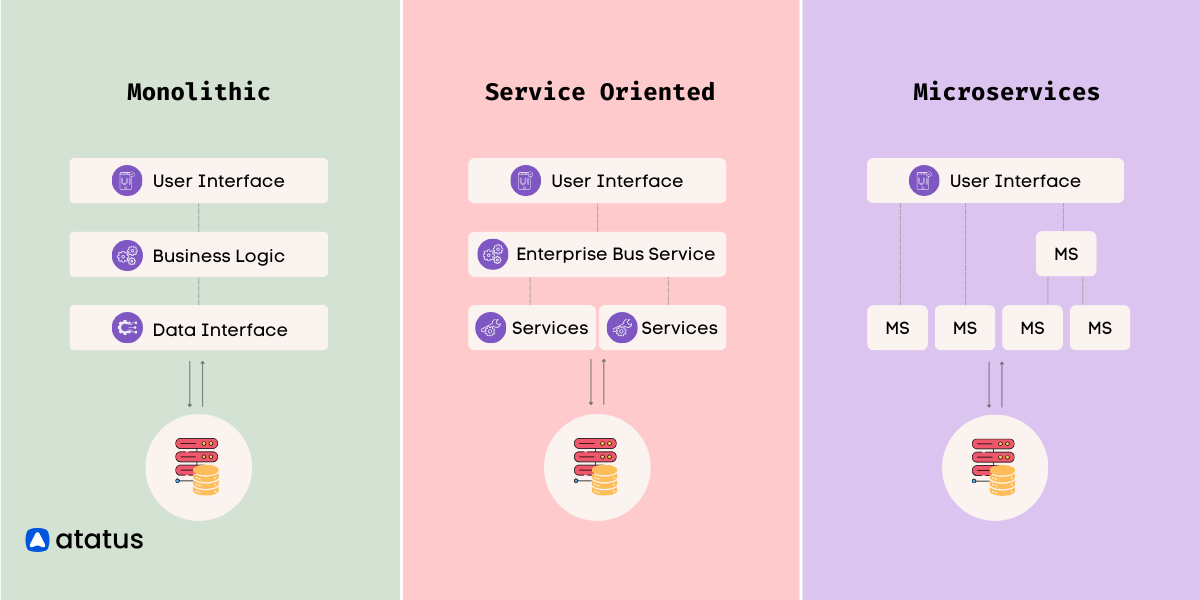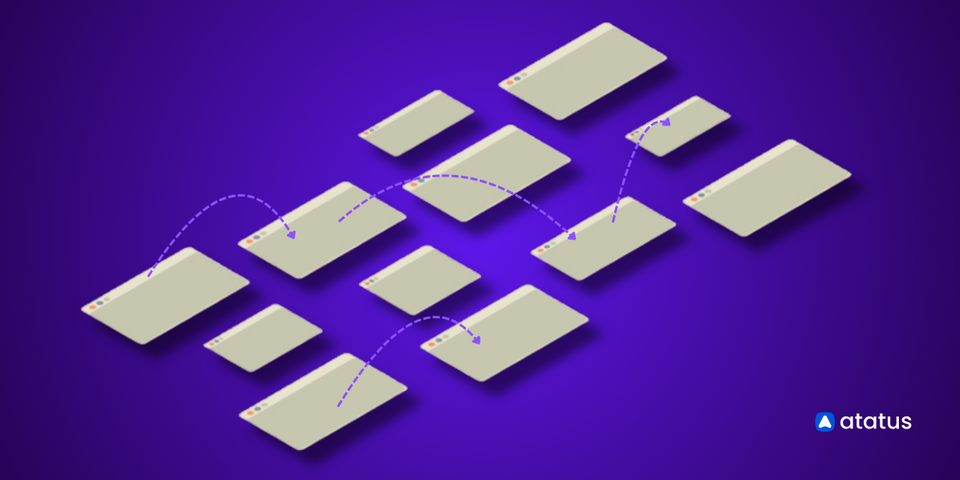Monolithic vs. SOA vs. Microservices: Which One Should You Choose?
In the dynamic realm of technology, how we conceive, construct, and uphold applications exerts a significant influence on their scalability, ease of maintenance, and ultimate prosperity.
Throughout this blog, we will embark on an expedition through the evolutionary trajectory of software architecture. Our exploration will encompass an in-depth analysis of the merits and drawbacks inherent to each approach, as well as an illumination of the factors that underpin the decisions undertaken by developers.
Our exploration will span from the cohesive framework of Monoliths to the decentralized essence of Service Architecture, and finally, to the refined modularity of Microservices. In doing so, we will traverse the evolutionary path of software design.
This blog is going to provide you with a thorough grasp of these architectures, empowering you to make educated choices when selecting the optimal approach for your projects.
Whether you're an experienced developer, a curious tech enthusiast, or a decision-maker striving to enhance your application's performance, this blog will offer valuable perspectives and practical know-how.
Table of Content
- What is Monolithic Architecture?
- What is Service Oriented Architecture (SOA)?
- What are Microservices?
- Differences Between a Monolith, Services, and Microservices
What is Monolithic Architecture?
Monolithic architecture represents a conventional approach to software design, wherein an entire application is constructed as a unified, standalone unit.
Within this framework, all elements, features, and services of the application are closely interwoven and interconnected, resulting in a unified entity. In essence, the application is conceptualized and developed as a singular, monolithic entity.
A client-side user interface, a server-side application, and a database often make up such a solution. All of the functions are controlled and provided in a single location since it is unified.
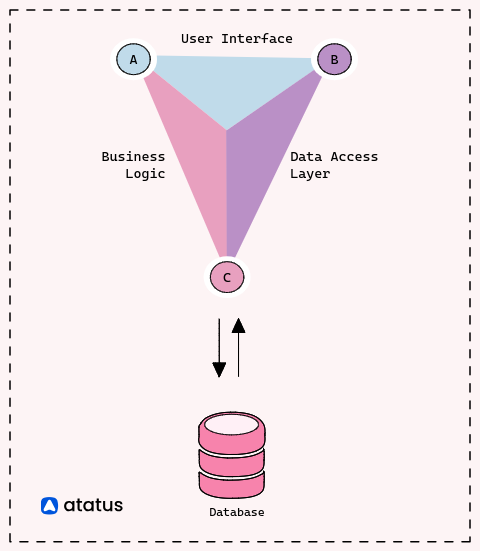
Changing this kind of application necessitates accessing the code base, developing and delivering a new service-side interface, and updating the complete stack. Updates are therefore limited and time-consuming.
During the initial stages of a project, monolithic architectures can offer convenience due to their simplified code management, reduced cognitive load, and streamlined deployment process. This setup enables the simultaneous release of all components within the monolith.
Numerous prominent companies have implemented monolithic architecture within their software systems at different points in their histories. Here are a few examples:
- Amazon: During its initial phases, Amazon utilized a monolithic architecture for its e-commerce platform. As the company evolved, it moved towards service-oriented and microservices architectures to manage increased complexity.
- eBay: A pioneer in online marketplaces, eBay also started with a monolithic architecture for building its platform. Over time, eBay adopted a hybrid strategy, blending monolithic components with microservices.
- Netflix: Although known for its microservices architecture today, Netflix initially operated with a monolithic architecture. However, the company gradually transitioned to microservices to enhance flexibility, scalability, and maintainability.
- Facebook: In its early stages, Facebook employed a monolithic architecture. As it expanded its offerings and user base, the company shifted to a more service-oriented architecture to accommodate diverse functionalities.
- Twitter: Twitter's origins can be traced back to a monolithic application. As its user numbers surged, Twitter faced scalability issues, prompting a transition to a more distributed architecture that integrated microservices.
Components of Monolithic Architecture
The entire programme is developed as a single unit in a monolithic design, making it very simple to develop and deploy, especially for smaller projects. The following are the main components of a monolithic architecture:
- Single Codebase: The entire application is written and maintained as a single codebase in a monolithic architecture. This contains all of the application's modules, functionalities, and features.
- Presentation Layer: The user interface (UI) and user interaction are taken care of by this layer. It consists of elements that render HTML, handle user inputs, and present data to users.
- Business Logic Layer: The business logic layer comprises the application's basic functionality and rules. It includes the processing, calculations, and operations that define the behaviour of the application.
- Data Access Layer: This layer is in charge of communicating with the database or data storage. It has parts that control database connections, run queries, and obtain or update data.
- Database: The monolithic architecture typically stores all application data in a single database instance. This core database is accessible by the application's many components to read and write data.
- Integration Layer: If the application needs to communicate with external systems or services, the integration layer handles these interactions. This can involve connecting to third-party APIs, services, or other software components.
- Security and Authentication: Monolithic architectures use a centralised approach to security and authentication. Security and user authentication techniques are implemented and enforced across the program.
Let's explore the example of the E-Commerce application using a monolithic architecture, but with a different scenario and context:
Monolithic Architecture for Online Marketplace:
In this scenario, we'll consider an online marketplace where multiple vendors can list and sell their products. The entire application, including the user interface and backend services, is tightly integrated into a single codebase and deployed as a monolithic system.
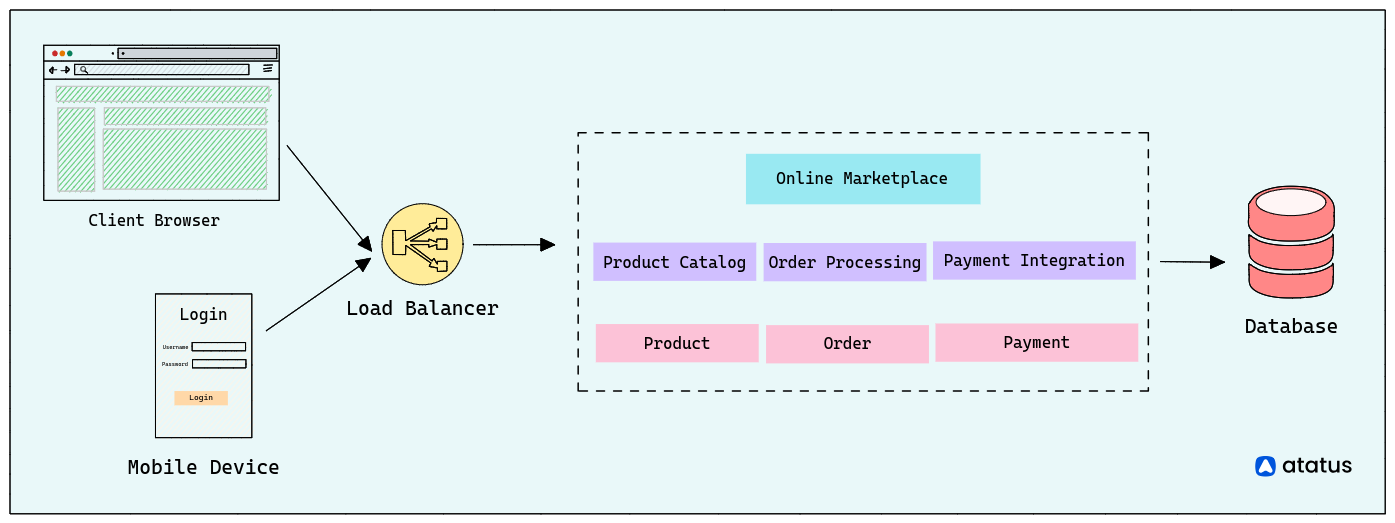
Components and Modules:
- Online Marketplace UI: The frontend of the application provides a platform for customers to browse products, add items to their cart, place orders, and manage their accounts.
- Vendor Management: This module allows vendors to register, create product listings, manage inventory, and track their sales.
- Product Catalog: Responsible for managing the catalog of products available on the marketplace. It includes details about each product, such as descriptions, prices, and images.
- Order Processing: This module handles the process of creating and processing customer orders. It calculates order totals, applies discounts, and notifies vendors of new orders.
- Payment Integration: Interacts with payment gateways to authorize and process customer payments. It ensures secure and seamless payment transactions.
- Shipping and Fulfillment: After successful payment authorization, this component manages the logistics of shipping products to customers. It communicates with vendors to coordinate order fulfillment.
Database:
A single relational database is used to store all relevant data, including customer accounts, product information, order history, vendor details, and payment records.
Advantages:
- Easier to develop initially.
- Simplified testing and debugging.
- Suitable for smaller projects.
Disadvantages:
- Scaling challenges.
- Complex maintenance and updates.
- Limited flexibility.
What is Service Oriented Architecture (SOA)?
SOA is an architectural style that focuses on creating and organising software systems as a collection of loosely connected and interoperable services.
In SOA, each service represents a specific business function or piece of functionality and may be developed, deployed, and maintained independently.
These services communicate with one another via well-defined interfaces, generally utilising standardised protocols like HTTP or SOAP.
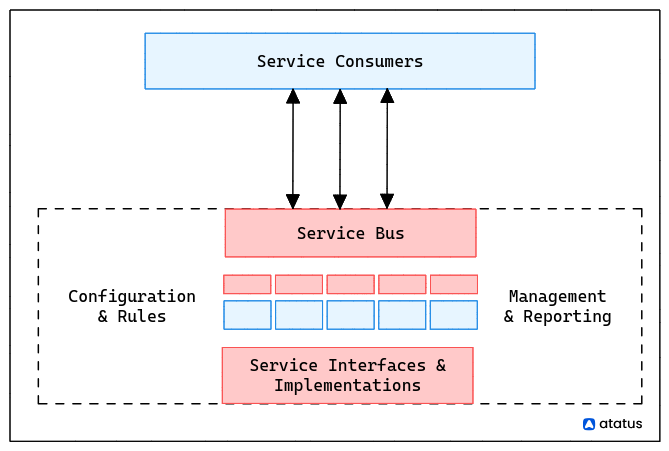
Here are a few instances of companies that have harnessed SOA:
- IBM: IBM has actively advocated for SOA and provides tools and solutions tailored to implementing service-oriented architectures within enterprise environments.
- Microsoft: SOA principles are embedded within Microsoft's products and services, including Azure cloud services and various enterprise software solutions.
- Salesforce: Salesforce's CRM platform revolves around a service-oriented model, empowering businesses to personalize and integrate services to match their specific requirements.
- Walmart: SOA drives Walmart's management of expansive e-commerce and retail operations, facilitating seamless interactions among diverse systems and services.
- Bank of America: Financial institutions such as Bank of America utilize SOA to seamlessly integrate diverse banking services, enhance customer experiences, and ensure regulatory compliance.
Components of SOA
SOA consists of several essential components that collaborate to establish a flexible and modular software structure. These components enable the creation, deployment, and interaction of services within the SOA framework.
Here are the main components of SOA:
- Services: Services serve as the foundational units of SOA, encapsulating distinct functionalities or business logic. Services are designed to be reusable, self-contained, and modular.
- Service Provider: The role of the service provider involves crafting, implementing, and hosting services. It exposes the service's functionality through well-defined interfaces.
- Service Consumer: The service consumer refers to a client application that solicits and utilizes services. It interacts with services using their published interfaces.
- Service Registry: The service registry acts as a repository where descriptions and metadata of services are stored. This allows service consumers to discover available services along with their particulars.
- Service Contract: A service contract outlines the agreements, regulations, and specifications adhered to by both the service provider and the consumer. It encompasses information about the service's inputs, outputs, and behaviour.
- Service Interface: The service interface delineates the methods, operations, and parameters that clients can employ to interact with the service. It defines how a service can be invoked.
- Security and Governance: SOA components often integrate security measures and governance policies to ensure secure and compliant interactions between services.
- Enterprise Service Bus (ESB): In more intricate SOA setups, an ESB may be utilized. An ESB is a middleware solution that facilitates communication, mediation, and integration among diverse services.
Advantages:
- Better scalability.
- Reusable services.
- Easier maintenance and updates.
Disadvantages:
- Complexity in managing services.
- Potential communication overhead.
What are Microservices?
Microservices represent an architectural strategy used to create software applications. Organizing these applications into compact, autonomous, and loosely connected services.
Each microservice is self-contained and handles a distinct business function or feature. These microservices interact with one another through clearly defined APIs.
The objective of employing microservices is to bolster agility, scalability, and ease of maintenance by dissecting applications into smaller, more manageable parts.
Companies using Microservice architecture:
- Uber: Uber relies on Microservices to manage rides and payments seamlessly.
- Spotify: Spotify's music app employs Microservices for personalized recommendations.
- Airbnb: Airbnb's lodging platform uses Microservices for hassle-free bookings.
- Nike: Nike's online store benefits from Microservices for personalised shopping.
Components of Microservice Architecture
Microservice architecture comprises several essential components that collaboratively establish a modular and distributed system. These components facilitate the creation, deployment, and operation of individual microservices within the architecture.
Here are the primary components of Microservice architecture:
- Microservices: The foundation of the architecture, microservices are distinct building blocks, each encapsulating a specific business capability or function.
- Service Registry: Serving as a central directory, the service registry enables microservices to register themselves, simplifying the discovery and interaction with other services.
- API Gateway: The API gateway acts as the primary entry point for external clients to access microservices. It offers a unified interface, manages authentication, and enforces security policies.
- Service Discovery: Facilitating the location of microservices within the system, service discovery is vital for dynamic environments where services can be added, removed, or relocated.
- Load Balancing: Load balancers distribute incoming traffic across multiple instances of a microservice, optimizing resource utilization and responsiveness.
- Centralized Configuration: A centralized configuration management system enables microservices to access configuration settings from a single source, enhancing consistency and manageability.
- Database Per Service: Each microservice can possess its database, ensuring data isolation and enabling efficient data management.
- Event Bus / Message Broker: The event bus or message broker facilitates asynchronous communication between microservices, enabling event-driven architecture and reducing coupling.
- Caching: Implementation of caching mechanisms stores frequently accessed data, reducing redundant processing needs.
- Monitoring and Logging: Microservices generate logs and metrics for monitoring. Centralized monitoring tools aid in tracking service health and performance.
- Containerization / Orchestration: Utilizing container technologies like Docker and orchestration platforms such as Kubernetes offers deployment and scaling capabilities for microservices.
- Security and Identity Management: Ensuring security measures like authentication and authorization safeguards microservices and enforces appropriate access controls.
- Resilience and Circuit Breakers: Techniques like circuit breakers and fault tolerance mechanisms enhance architecture resilience against failures.
- Continuous Integration and Deployment (CI/CD): Automation tools facilitate continuous integration, testing, and deployment, enabling swift microservice updates.
- Development and Testing Tools: Tools aiding microservice creation, testing, and debugging are pivotal for efficient development processes.
Advantages:
- Exceptional scalability and flexibility.
- Independent development and deployment.
- Adaptable to changing requirements.
Disadvantages:
- Complexity in managing a large number of services.
- Potential overhead in inter-service communication.
Differences Between Monolith, Services, and Microservices
| Aspect | Monolithic Architecture | Services Architecture | Microservices Architecture |
|---|---|---|---|
| Structure | Single, tightly coupled application. | Multiple services are interacting. | Many small, independent services. |
| Communication | Direct method/function calls within the application. | Inter-service communication through APIs. | Inter-service communication through APIs or events. |
| Scalability | Scaled as a whole application. | Scaled by adding instances of specific services. | Scaled by adding instances of individual services. |
| Flexibility | Limited technology choice. | Some technology diversity in separate services. | Extensive technology diversity in isolated services. |
| Deployment | Single deployment unit. | Independent deployment of services. | Independent deployment of microservices. |
| Maintenance | Modifications can impact the entire application. | Modifications in services have isolated effects. | Modifications in microservices have isolated effects. |
| Team Collaboration | The entire team works on one codebase. | Teams collaborate on separate services. | Teams collaborate on individual microservices. |
| Fault Isolation | A single failure can affect the entire system. | Failures are contained within specific services. | Failures are contained within individual microservices. |
| Complexity Management | Higher complexity due to tightly coupled components. | Moderate complexity with decoupled services. | Lower complexity with highly decoupled microservices. |
Conclusion
As technology advances, the requirement to maintain these technologies also expands in parallel. Consequently, various architectural systems emerge and fade over time. Initially, there was the monolith architecture, followed by the Service-Oriented Architecture (SOA), and presently, the most popular and extensively adopted approach is microservices.
Those seeking rapid development, simplicity, and minimal latency may opt for the Monolithic architecture. SOA enables modular services for reuse in different apps, reducing costs and development time. It boosts adaptability to changing business needs. In finance, SOA integrates banking systems, payment gateways, risk tools, and more.
Microservices excel when organizations need to modify functionality and deploy changes without system-wide impact. This demonstrates their power in seamless feature deployment without downtime. For businesses relying on web/mobile apps like e-commerce, social media, and online services, microservices offer advantages in managing diverse features effectively.
In conclusion, microservices have gained immense popularity as a widely utilized distributed architecture, playing a significant role in modern IT operations.
Monitor Your Entire Application with Atatus
Atatus is a Full Stack Observability Platform that lets you review problems as if they happened in your application. Instead of guessing why errors happen or asking users for screenshots and log dumps, Atatus lets you replay the session to quickly understand what went wrong.
We offer Application Performance Monitoring, Real User Monitoring, Server Monitoring, Logs Monitoring, Synthetic Monitoring, Uptime Monitoring, and API Analytics. It works perfectly with any application, regardless of framework, and has plugins.

Atatus can be beneficial to your business, which provides a comprehensive view of your application, including how it works, where performance bottlenecks exist, which users are most impacted, and which errors break your code for your frontend, backend, and infrastructure.
If you are not yet an Atatus customer, you can sign up for a 14-day free trial.
#1 Solution for Logs, Traces & Metrics
APM
Kubernetes
Logs
Synthetics
RUM
Serverless
Security
More

